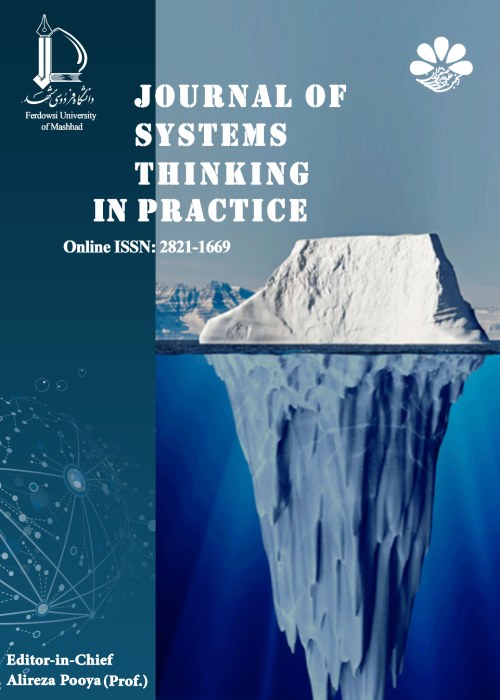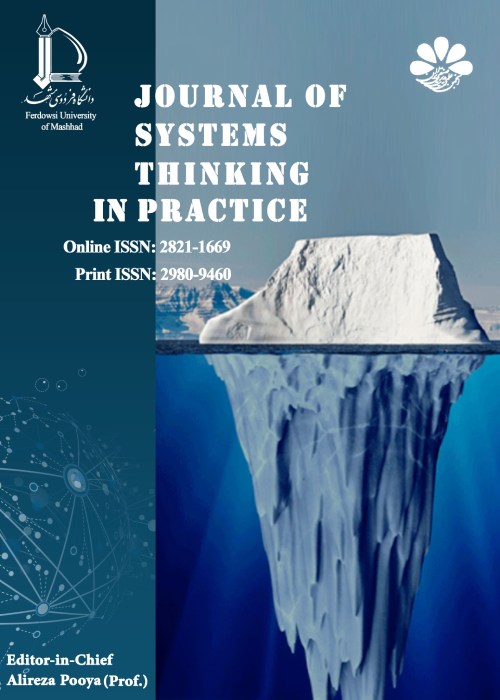فهرست مطالب

Journal of Systems Thinking in Practice
Volume:2 Issue: 2, Jun 2023
- تاریخ انتشار: 1402/03/11
- تعداد عناوین: 6
-
-
Pages 1-32This qualitative study aims to develop the framework for the entrepreneurship education ecosystem in Iranian schools. This study developed the ecosystem framework for entrepreneurship teaching in schools using Soft Systems Methodology. The Soft Systems Methodology is employed in a problematic situation that necessitates improvement. In the entrepreneurship education ecosystem of Iranian schools, the educational structure is unfavourable, and the students’ entrepreneurial capacities have not been realized, so soft systems methodology was used to improve these conditions. This study adopted a methodology with seven processes, five of which are carried out in the real (physical) world, and three involve system thinking and the human mental world. The problematic situation of entrepreneurship education in schools was determined using Soft Systems Methodology, and the actors and relationships were designed. The conceptual models corresponding to the main actors were obtained from the interviews with the actors in this field. Finally, by combining models, the integrated model of developing the framework of the entrepreneurship education ecosystem in Iranian schools was obtained. Then, necessary actions to realize this desired model were brought from the perspective of each of the actors. The development of a structure by the Ministry of Education to establish offices of industries and start-ups in schools to involve students in entrepreneurial activities has been accomplished to achieve the desired model. This study has educational, theoretical, and policy benefits for entrepreneurship education in Iran and the world. The supporting elements of entrepreneurship education in Iranian schools and the essential strategies were described. The present study's academic contribution lies in developing the entrepreneurship education ecosystem, examining how its components interact, and identifying the necessary actions for each.Keywords: Entrepreneurship education, entrepreneurship in schools, entrepreneurship education ecosystem, entrepreneurial competencies, Soft systems methodology
-
Pages 33-55In today's competitive world, discovering the needs and desires of customers and fulfilling them before competitors is the condition for success for companies. Therefore, organizations and business enterprises try to achieve a privileged position compared to other competitors by achieving unique advantages. This study aims to develop the importance-performance analysis by adding the cost dimension. Then, measure and compare the quality of the services of two communication networks, Hamrahe Aval, and Irancell, using the developed approach of Importance-Performance-Cost Analysis (3-D IPCA) and proposing the optimal strategy to improve service quality. For this purpose, were identified the relevant attributes by studying the literature, then provided to the experts in the form of a questionnaire for final confirmation. Finally, 20 attributes were identified in determining the quality of mobile phone operators' services. The questionnaire was distributed among 400 Ferdowsi University of Mashhad students as a convenience sample. Then it was analyzed using three-dimensional IPCA analysis.The results showed that among the users of the Hamrahe Aval network, the quality of providing services and customer support, and among the users of the Irancell network, network coverage and ease of use of services have the highest and lowest priorities for improvement, respectively. Also, Irancell's performance has been better considering the cost aspect. The comparison of IPA and IPCA shows that IPCA considering the cost as a third dimension can obtain more accurate analyzes of customers' opinions. Moreover, managers can make more rational decisions with this tool.Keywords: Importance-Performance Analysis, Cost Dimension, Service Quality, Mobile Operator
-
Pages 56-77
According to various societal problems, the related problems and issues are expected to be solved gradually. However, by referring to the responsible organizations, we realize that appropriate actions have not been implemented to solve those problems. Regarding the role of systems thinking in organizational learning and improvement, whether the organization is at the proper level of systems thinking to carry out empowering projects should be considered. This research aims to determine an appropriate evaluation model based on experts' opinions to evaluate the organisation's level of systems thinking, which is a research gap regarding the reviewed articles. The proposed research methodology consists of three main phases: defining evaluation indicators and criteria, completing the questionnaire based on the fuzzy Delphi technique and Kendall's coefficient, and determining the organization's systems thinking maturity level. A case study was conducted for an Iranian oil company; it was determined that the company was at the systems thinking confrontation of thoughts level. Therefore, it is necessary to make appropriate arrangements to promote the systems thinking of that company. The main contribution of the research is to provide an evaluation model of the systems thinking level of the organization based on the excellence model of the systems thinking levels of the organization. The unique feature of the proposed model is to pay attention to the thinking style, attitudinal and interactive criteria of systems thinking, including 33 criteria categorized into three leading indicators. This research suggests using the presented model to evaluate the level of systems thinking in different organizations and companies and to implement appropriate approaches to improve the level of systems thinking in organizations and companies before implementing any organizational empowering project.
Keywords: Systems thinking, Fuzzy Delphi, thinking styles, Evaluation model, Excellence levels of organizational systems thinking -
Pages 78-92The COVID-19 pandemic is one of the most critical issues in the world today. Although many countries have been able to control the infection, much research is still needed to uncover the complex dynamics of virus transmission. This study aimed to utilize a mathematical model for analyzing epidemiological data of infectious diseases, aiming to comprehend their behavior, predict future trends, and investigate the influence of external factors on key indicators. This model extends the Susceptible-Exposed-Infected-Recovered (SEIR) framework by incorporating additional populations, such as vaccinated individuals, asymptomatic cases, and hospitalized patients. It also developed dynamics related to vaccination avoidance behavior and adherence to health protocols. It is coded in MATLAB 2018-b software and is executed for 360 days. The results of the simulation showed that it is not possible to achieve the desired level of immunity from vaccine injection without following health protocols. On the other hand, considering the level of infection, increasing the participation rate in receiving vaccines and reducing the population of vaccines can control the epidemic. Therefore, a change in social behavior and an increase in the amount of vaccination can increase the awareness of society in reducing the avoidance of vaccination and improving compliance with health protocols.Keywords: A dynamic system, SEIR model, Covid-19 Pandemic, Vaccination Avoidance
-
Pages 93-114Customer satisfaction is the main condition for competing in the global market. In the international market, customer requirements or needs have been turned into a primary concern for organizations. Also, numerous studies have shown that customer satisfaction has a positive effect on organizations’ profitability. In order to attract and retain customers, it is essential to identify and classify their requirements and predict them for organizations. Ideally, every organization should fully understand each of its customers, which is impossible in practice, so this study has used the market segmentation technique to identify customer needs. After the market segmentation, appropriate services should be provided for each segment to achieve customer satisfaction. One of the powerful techniques in this field is the Kano model. Investing in the motivational needs of customers and obtaining their satisfaction requires identifying the most important motivational needs. Therefore, in this study, the combinations of the K-means, Kano, and fuzzy analytic hierarchy process (FAHP) methods are used.Keywords: Quality requirement, Kano model, K-means, Fuzzy AHP
-
Pages 115-139One of the most valuable assets for organizations is the brand of their products and services, as building a strong brand is critical to achieving competitive advantage and long-term survival in the marketplace. In this regard, it is necessary to constantly pay special attention to the status of the brand value compared to competitors to avoid the effects of fake news. Brand equity should be considered and investigated from different aspects because different factors, such as brand awareness, brand loyalty, brand association, perceived quality, and brand awareness, can affect brand equity over time. So, this concept is dynamic in marketing management. Therefore, in this research, using the system dynamics approach, a dynamic model is presented to investigate brand equity, focusing on fake news from the Coca-Cola Company, to understand better the marketing managers of the mechanism of brand equity changes over time. The simulation outcomes demonstrated that the unique brand value and the factors influencing it do not change instantly but interact via feedback loops and build-up over time. The second stage's simulation findings revealed that fake news dissemination, brand equity, perceived quality, and brand awareness changed more than they did in the first. Customer loyalty is also influenced by perceived quality. The number of consumers who believe in the reputation and credibility of the company declines with the spread of fake information. Based on the outcomes of the simulation and the application of the policy of increasing customer knowledge, it was determined that the organization's investment to increase the customer's knowledge of the products and remove the misunderstandings brought on by fake information could increase trust in the brand and lead to the neutralization of the effect of fake news on the brand value and the factors affecting it.Keywords: Dynamic model, brand equity, Fake News, customer knowledge, Coca-Cola Company


